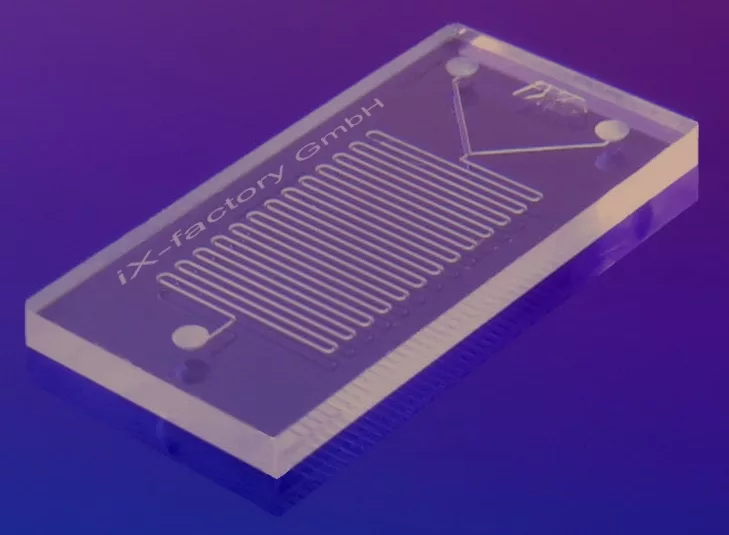The intersection of microfluidics and biological research is redefining the future of medicine. Image credit: Sven Tombrink, Wikimedia commons, CC BY SA 3.0.
The latter half of the 20th century encompassed scientific revolution. Nevertheless, the corresponding technologies were laborious and incompatible with high throughput demands. These issues, often involving macroscopic liquid manipulation, have partly been resolved by applying physical principles in a biological context, through the development of microfluidics. This involves the manipulation of small amounts of liquids, ranging from microlitre to picolitre volumes. Such technology, and those well versed in its use, have increased over the past two decades and now, microfluidics is crucial in a wide range of biological research.
Organ-on-a-chip
Despite the prolific use of non-human primates (NHP) in preclinical drug testing, the complexities of human organ systems cannot truly be recapitulated in these models. Instead, models more reflective of human biology are necessary to overcome the ethical and applicability issues regarding animal models. In 2010, a group of researchers from Harvard University integrated a microfluidic system with an extracellular matrix and respiratory tissue, forming a biomimetic lung chip which reflected in vivo physiological processes. One of the co-authors, Donald Ingber, later founded Emulate, a biotechnology company that has commercialised and advanced organ chip technology.
One success story stemming from Emulate is their liver chip. The predictive validity of 870 Emulate liver chips was tested using 27 drugs of varying toxicity to liver cells (hepatotoxicity). Such validity was compared to that of animal models and cultures of human hepatocytes, both popular preclinical models. Of 15 toxic drugs, the liver chips were sensitive to 12, indicating greater sensitivity to toxicity than hepatic cultures which showed only 42% sensitivity to the same drug set. Importantly, no drugs were erroneously attributed toxic. Animal models, however, previously permitted the toxic drug into clinical trials.

The future of organ chip technology
Microfluidics underlie a technology capable of making animal testing obsolete. As organ chips more accurately distinguish hepatoxic drugs, and show no inaccurate ‘toxic’ attributions, the transition to preclinical chip models is advantageous.
The NHP industry is already showing ecological and moral collapse as the demand for NHPs has increased. Namely, Charles River Laboratories, an affluent pharmaceutical company who outsources animals for clinical research, was recently accused of capturing wild Cambodian long-tail macaques. The illegal capture of wild animals jolts their ecosystem out of balance, impacting higher and lower trophic levels, and drives the macaque population down.
The United States-Cambodian “monkey smuggling ring” was supposedly terminated by the U.S. Fish and Wildlife Service. However, Charles River Laboratories appears to have circumvented this termination by instead flying the animals to Canada. Despite the claim that ‘employees…are committed to the highest level of animal welfare’, Charles River Laboratories show no concern for the animals they capture.
Microfluidics underlie a technology capable of making animal testing obsolete.
In December of 2022, the FDA Modernisation Act 2.0 was written into law, stating that animal models are not necessary for FDA drug approval; instead, organ-chips are a sufficient alternative. Additionally, human-on-a-chip models, with at least 10 organs, provide insight into in vivo processes in in vitro conditions, and these may eradicate the need for animals to test whole body responses. Thus, organ-chip technology and the underlying microfluidics, are crucial in redeveloping preclinical research practices.
Microfluidics in space
As further and more extensive space missions are planned, ensuring the health of astronauts is a top priority of NASA. Last year, Samantha Cristoforetti of the SpaceX Crew-4 team successfully tested the Reusable Handheld Electrolyte and Laboratory Technology for Humans (rHEALTH) biomedical analyser on the International Space Station. The rHEALTH technology uses microfluidics to prepare bodily fluid samples prior to analysis.
A vast array of tests indicative of kidney and blood health are close to approval, and therefore, the rHEALTH instrument is an inviting diagnostic tool for astronauts. The conditions and threats in space differ from that on Earth, and this, combined with the inaccessibility of traditional treatments, means that diagnostic ease is a necessity on space missions. rHEALTH may enable the simple monitoring of astronaut health to identify any abnormalities before they become too severe. As microfluidic innovation is becoming extra-terrestrial, it is clear the capabilities of the technology are not limited to earth.
Bacteria power
The concept of motion is often associated with macroscopic organisms and technology; however, many microorganisms can self-propel. This property has been harnessed to drive motors at a microscopic level. Microscopic gears within a Bacillus subtilis suspension rotate given certain conditions, such as the bacterial suspension being above a concentration indicative of collective self-propulsion. Nevertheless, as nutrients required for active movement depleted, and secreted surfactants increased suspension viscosity, rotation ceased. Research like this, and others, suggest that bacteria power can generate movement within specific environments.
The implications this has for macroscopic bacteria power are not yet fully explored. The principles of bacterial motion in microscopic volumes may be applicable to larger mechanical systems. If one could harness microorganism power at a greater scale, motion need not rely on conventional energy. Microorganisms, therefore, may provide a new source of renewable energy.
Lab-on-a-molecule
To recapitulate the workings of a lab onto a chip was unimaginable only decades ago. Now, protein interactions may be inferred from single molecules. The Wyss Institute at Harvard University has recently developed DNA nanoswitch technology. A DNA molecule acts as a programmable switch, transitioning from a linear to looped conformation upon the interaction of different bound molecules. Gel electrophoresis then separates and identifies the looped conformation. When these bound molecules are disease-related proteins, the DNA can be immersed in a solution with a potential therapeutic agent, and the resulting DNA conformation reveals the suitability of this agent as a drug candidate.
In 2022, the project was selected as a Wyss Institute Validation Project that recognises research with great potential impact. The subsequent funding by Northpond Labs aims to commercialise the currently theoretical technology. The future of DNA nanoswitches is limitless, potentially assisting drug discovery, or elucidating protein function.
The future of DNA nanoswitches is limitless, potentially assisting drug discovery, or elucidating protein function.
Interestingly, the absence of microfluidics here suggests that lab-on-a-chip research, which relies on microfluidics, may not be sufficient throughout future drug discovery processes. While microfluidics show exciting potential and no indication of an expiration date, other technologies may be necessary to supply the high throughput demand.
Microfluidics revealing the macroscopic world
Microfluidics make a visible world even brighter. The processes in the macroscopic world are often too complex to conceptualise at a macroscopic level. Instead, these processes can be inferred from a microscopic world. Microfluidics has enriched our understanding throughout science, including vaccinology and clinical testing, even being tested in space. However, the future of demanding sectors such as drug discovery, appear not to be dominated by microfluidics.
It is plausible to envision a future where lab-on-a-chip research works in conjunction with lab-on-a-molecule, particularly within drug discovery. Perhaps, a new drug can be entirely developed in an area no larger than an AA battery.





